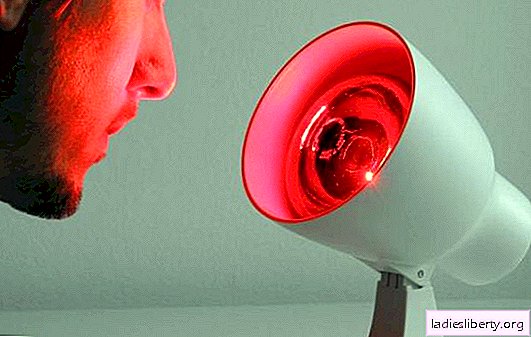
Infrared (IR) rays are electromagnetic waves. The human eye is not able to perceive this radiation, but the person perceives it as thermal energy and feels it with the whole skin. We are constantly surrounded by sources of infrared radiation, which differ in intensity and wavelength.
Should infrared rays be feared, do they bring harm or benefit to a person and what is their effect?
What is infrared radiation, its sources
As you know, the spectrum of solar radiation, perceived by the human eye as a visible color, is between the violet waves (the shortest - 0, 38 microns) and red (the longest - 0.76 microns). In addition to these waves, there are electromagnetic waves that are not accessible to the human eye - ultraviolet and infrared. "Ultra" means that they are below or, in other words, less violet radiation. Infra, respectively, is above or more red radiation.
That is, infrared radiation is electromagnetic waves lying beyond the red color range, the length of which is longer than that of the visible red radiation. Studying electromagnetic radiation, the German astronomer William Herschel discovered invisible waves that caused the temperature of the thermometer to rise, and called them infrared thermal radiation.
The natural most powerful source of thermal radiation is the Sun. Of all the rays emitted by the luminary, 58% falls on the share of infrared. Artificial sources are all electric heaters that convert electricity into heat, as well as any objects whose temperature is above the absolute zero mark - 273 ° C.
Infrared Properties
IR radiation has the same nature and properties as ordinary light, only a large wavelength. Light waves visible to the eye, reaching objects, are reflected, refracted in a certain way, and a person sees the reflection of the object in a wide range of colors. And infrared rays, reaching an object, are absorbed by it, releasing energy and heating this object. We do not see infrared radiation, but we perceive it as heat.
In other words, if the Sun did not emit a wide range of long-wave infrared rays, a person would only see sunlight, but not feel its heat.
It is hard to imagine life on Earth without solar heat.
Some of it is absorbed by the atmosphere, and the waves reaching us are divided into:
• short - the length lies in the range 0.74 microns - 2.5 microns, and their objects exude heated to a temperature of more than 800 ° C;
• medium - from 2.5 microns to 50 microns, t heating from 300 to 600os;
• long - the widest range from 50 microns to 2000 microns (2 mm), t to 300 ° C.
The properties of infrared radiation, its benefits and harm to the human body, are determined by the radiation source - the higher the temperature of the emitter, the more intense the waves and their deeper penetration, the degree of impact on any living organisms. Studies conducted on the cellular material of plants and animals have revealed a number of useful properties of IR rays, which have found widespread use in medicine.
The benefits of infrared radiation for humans, medical applications
Medical studies have proven that for a person not only safe, but also very useful infrared rays that are in a long range. They activate blood flow and improve metabolic processes, inhibit the development of bacteria and contribute to the rapid healing of wounds after surgery. They contribute to the development of immunity against toxic chemicals and gamma radiation, stimulate the elimination of toxins, toxins through sweat and urine and lower cholesterol.
Especially effective are the rays with a length of 9.6 microns, which contribute to the regeneration (restoration) and recovery of organs and systems of the human body.
From time immemorial, in traditional medicine, treatment with heated clay, sand or salt has been used - these are vivid examples of the beneficial effects of thermal IR rays on humans.
Modern medicine for the treatment of a number of diseases has learned to use useful properties:
• using infrared radiation can treat bone fractures, pathological changes in the joints, relieve muscle pain;
• IR rays have a positive effect in the treatment of paralyzed patients;
• quickly heal wounds (postoperative and others), relieve pain;
• due to the stimulation of blood circulation, help normalize blood pressure;
• improve blood circulation in the brain and memory;
• remove heavy metal salts from the body;
• have a pronounced antimicrobial, anti-inflammatory and antifungal effect;
• strengthen the immune system.
Bronchial asthma, pneumonia, osteochondrosis, arthritis, urolithiasis, bedsores, ulcers, sciatica, frostbite, digestive diseases - this is not a complete list of pathologies for the treatment of which the positive effect of infrared radiation is used.
Heating of premises with the help of infrared radiation devices promotes ionization of the air, fights allergy, destroys bacteria, molds, improves the condition of the skin due to increased blood circulation. When purchasing a heater, it is necessary to choose long-wave devices.
Other applications
The property of objects to radiate heat waves has found application in various fields of human activity. For example, with the help of special thermographic cameras capable of capturing thermal radiation, in absolute darkness you can see and recognize any objects. Thermographic cameras are widely used in the military and industry to detect invisible objects.
In meteorology and astrology, IR rays are used to determine distances to objects, clouds, water surface temperatures, etc., infrared telescopes allow you to study space objects that are inaccessible to vision through conventional devices.
Science does not stand still and the number of infrared devices and their fields of application is constantly growing.
Harm
A person, like any body, emits medium and long infrared waves that lie in the range from 2.5 microns to 20-25 microns in length, therefore it is precisely waves of this length that are completely safe for humans. Short waves are able to penetrate deeply into human tissues, provoking heating of internal organs.
Short-wave infrared radiation is not only harmful, but also very dangerous for humans, especially for the visual organs.
Solar thermal shock, provoked by short waves, occurs when the brain is heated by only 1C. Its symptoms are:
• severe dizziness;
• nausea;
• increased heart rate;
• loss of consciousness.
Metallurgists and steelmakers, constantly exposed to the thermal effects of short infrared rays, are more often than others exposed to diseases of the cardiovascular system, have weakened immunity, and are more often exposed to colds.
In order to avoid the harmful effects of infrared radiation, it is necessary to take protective measures and limit the time spent under hazardous rays. But the use of thermal solar radiation for life on our planet is undeniable!











